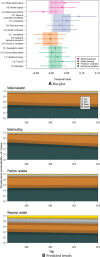Standards for distribution models in biodiversity assessments
- PMID: 30746437
- PMCID: PMC6357756
- DOI: 10.1126/sciadv.aat4858
Standards for distribution models in biodiversity assessments
Abstract
Demand for models in biodiversity assessments is rising, but which models are adequate for the task? We propose a set of best-practice standards and detailed guidelines enabling scoring of studies based on species distribution models for use in biodiversity assessments. We reviewed and scored 400 modeling studies over the past 20 years using the proposed standards and guidelines. We detected low model adequacy overall, but with a marked tendency of improvement over time in model building and, to a lesser degree, in biological data and model evaluation. We argue that implementation of agreed-upon standards for models in biodiversity assessments would promote transparency and repeatability, eventually leading to higher quality of the models and the inferences used in assessments. We encourage broad community participation toward the expansion and ongoing development of the proposed standards and guidelines.
Figures




References
-
- Lewis S. L., Maslin M. A., Defining the Anthropocene. Nature 519, 171–180 (2015). - PubMed
-
- Barnosky A. D., Matzke N., Tomiya S., Wogan G. O. U., Swartz B., Quental T. B., Marshall C., McGuire J. L., Lindsey E. L., Maguire K. C., Mersey B., Ferrer E. A., Has the Earth’s sixth mass extinction already arrived? Nature 471, 51–57 (2011). - PubMed
-
- Hooper D. U., Adair E. C., Cardinale B. J., Byrnes J. E. K., Hungate B. A., Matulich K. L., Gonzalez A., Duffy J. E., Gamfeldt L., O’Connor M. I., A global synthesis reveals biodiversity loss as a major driver of ecosystem change. Nature 486, 105–108 (2012). - PubMed
-
- Pereira H. M., Leadley P. W., Proença V., Alkemade R., Scharlemann J. P. W., Fernandez-Manjarrés J. F., Araújo M. B., Balvanera P., Biggs R., Cheung W. W. L., Chini L., Cooper H. D., Gilman E. L., Guénette S., Hurtt G. C., Huntington H. P., Mace G. M., Oberdorff T., Revenga C., Rodrigues P., Scholes R. J., Sumaila U. R., Walpole M., Scenarios for global biodiversity in the 21st century. Science 330, 1496–1501 (2010). - PubMed
-
- Urban M. C., Bocedi G., Hendry A. P., Mihoub J.-B., Pe’er G., Singer A., Bridle J. R., Crozier L. G., De Meester L., Godsoe W., Gonzalez A., Hellmann J. J., Holt R. D., Huth A., Johst K., Krug C. B., Leadley P. W., Palmer S. C. F., Pantel J. H., Schmitz A., Zollner P. A., Travis J. M. J., Improving the forecast for biodiversity under climate change. Science 353, eaad8466 (2016). - PubMed
Publication types
MeSH terms
LinkOut - more resources
Full Text Sources
Miscellaneous

